Smile Design Enhanced with Porcelain Veneers
Porcelain laminate veneers are among the most esthetic means of creating a more pleasing and beautiful smile
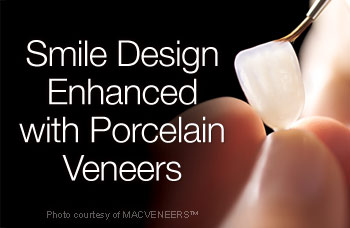
Part 1 of this series on smile design gave an overview of the many facets involved in beautifying smiles by design and the many ways of interpreting what is normal or ideal. Our first article discussed the role of the dentist as diagnostician, artist and scientist in meeting you the patient to decide the best course of action for your particular situation. A detailed analysis of your smile is critical to the correct assessment and the appropriate procedures for change or enhancement.
Porcelain laminate veneers are among the most esthetic means of creating a more pleasing and beautiful smile. Porcelain veneers within reason allow for the alteration of tooth position, shape, size and color. They require a minimal amount of tooth preparation — in this case reduction (approximately 0.5 mm of surface enamel) — and are, therefore, a more conservative restoration than a crown, which requires significant removal of sound tooth structure. Although not the only alternative for all esthetic abnormalities, they are truly a remarkable restoration when they are the treatment of choice.
What is a Veneer?
Simply stated, a veneer is a thin covering over another surface. In dentistry a veneer is a thin layer of dental restorative material, usually porcelain that replaces enamel.
Porcelain was named after its resemblance to the white, shiny Venus-shell, called in Old Italian “porcella.” The curved shape of the upper surface of the Venus-shell resembles the curve of a pig's back (from the Latin porcella – a little pig). Properties associated with porcelain are high strength, hardness, glassiness, high durability, translucence and high resistance to chemical attack.
Dental porcelain is a type used by dental technicians to create bio-compatible life-like crowns and bridges for dentistry. As you will note from the cases shown, dental porcelains in the right hands can make for spectacular tooth imitations by mimicking tooth enamel perfectly. This is also a testament to the artistic skill of the laboratory technicians with whom the dentist partners in producing life-like precision veneers to create your enhanced smile. The dentist will usually specify a shade of porcelain, corresponding to a set of mixtures of porcelain powder used in the laboratory. The powder corresponding to the basic tooth color is mixed with water, and then placed in an oven for “firing.” Further layers of porcelain are built up to mimic the natural translucency of the enamel of the tooth.
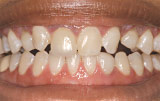 |
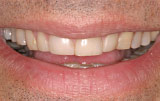 |
| Figure 1: Original smile before veneers | Figure 4: Original smile showing worn teeth |
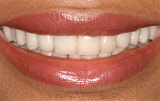 |
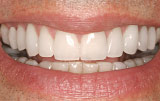 |
| Figure 2: Smile after “Hollywood White” veneers | Figure 5: Establishing normal tooth length with veneers |
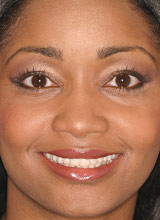 |
 |
| Figure 3: Portrait photo after “Hollywood White” veneers | Figure 6: Portrait photo showing “Enhanced White” veneers |
| Photos provided by Dr. Dean C. Vafiadis | |
A laminate is a material constructed by uniting two or more layers of material together in a process called lamination (in common parlance, lamination refers to sandwiching an object or material between layers of plastic and sealing them with heat and/or pressure, usually with an adhesive). The laminate structure refers to the combination of tooth, bonding interface and veneer complex. The veneer shell replacing the removed tooth enamel is chemically bonded to the underlying tooth surface with which it becomes part.
Before a patient can successfully receive veneer treatment, certain aspects related to his or her dental health and tooth structure must exist, verified by a smile analysis:
- The teeth are in more or less normal position;
- Sufficient tooth structure needed for veneers exists;
- Symmetrical gingival (gum) contours are present, which allow for the proper “framing” of the teeth necessary for a beautiful cosmetic result [Fig. 1,2 and 3].
What veneers can do — porcelain veneers are an excellent solution for correcting small or medium spaces between teeth, imperfections in tooth position (e.g., slight rotations), poor color, poor shape or contours, as well as some minor occlusal (bite) related problems. Porcelain veneers can allow for dramatic improvements for patients who have worn their teeth by bruxism (grinding of one's teeth through habit patterns) or fractured teeth [Fig. 4,5 and 6].
What veneers can't do — in considering the limitations of porcelain veneers, we should be reminded of another important definition of “veneer” — a deceptive, superficial show or a façade. So too, there are situations that the technique cannot correct, such as poor tooth position, large discrepancies in root position, poor bite relations and poor profile.
Many of these situations first require some form of orthodontics to move the teeth into proper position — for both function and esthetics. This important diagnostic determination is critical and defines the “brilliance” of your dentist. Porcelain veneers are an excellent form of tooth restoration, but as with any material used in the mouth, it does have limitations. There is no substitute for your dentist's expertise and consideration of your specific needs obtained from his or her diagnostic evaluation — they are critical to assure the successful result of a beautiful smile.

